Tooth Enamel Erosion Prevention
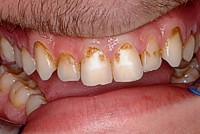 Red Bull Habit
Red Bull Habit
Enamel Erosion is a dental condition or result that has a seemingly infinite number of causes. The actual "process" of enamel breakdown is similar, however. Basic chemistry and molecular principles that operate in the "enamel environment" become disturbed or unbalanced. Most of us practice the basic interventions for correcting these imbalances on a daily basis.
Key Variable: Saliva
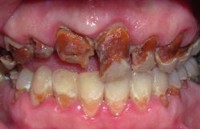 Mountain Dew addiction
Mountain Dew addiction
Oral hygiene is important, especially brushing our teeth after each meal (not too soon-you should wait half an hour), in the morning when we get up, and before we go to bed. Basic teeth-brushing serves to remove food particles and flush the oral cavity, which stimulates saliva production. When saliva production is not routinely overwhelmed with highly acidic foods, tooth enamel can endure a lifetime, given routine dental care. Since tooth structures and enamel are not self-regenerating, any perceived changes in saliva production (the experience of dry mouth) should not be overlooked or disregarded.
Acidity Environments
Highly acidic conditions in the oral cavity occur for two reasons, encompassing a variety of causes:
Excess Consumption of Acidic Foods
- Energy Drinks
- Energy Bars
- Soft Drinks (soda pop)
- Sports Beverages
- Sugared candies
- Sour candy
- Lime, Lemon, and other citrus fruits
- Processed snacks with high sugar content
- Coffee and tea beverages flavored with sugar
Xerostomia - Dry Mouth (cotton mouth)
- Reduced saliva flow
- Feature of an existing syndrome (e.g., Sjogren's Syndrome)
- Congenital Xerostomia
- Post chemotherapy medications
- Diabetic medications
- Amphetamine abuse
- Alcohol-based mouth rinses
- Allergic reactions to restorative dentistry components
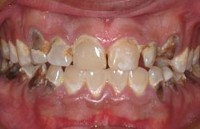 Basic Erosion
Basic Erosion
Early Intervention
Enamel destruction is cumulative. Patients should not assume that early signs of enamel deterioration will be reversed with mere changes in habits, or eating and drinking preferences. Many dentists, like Dr. Petulla and Dr. Kazemi, can provide a variety of medications or treatments that increase saliva production, including Salanium, Sensodyne toothpaste products, Oasis (saliva substitute), and Biotene products, some of which contain salivary enzymes (Lactoperoxidase, Lactoferrin, Lysozyme) that boost and replenish saliva's own defenses. MI Paste is also available, which helps to aid the natural remineralization process. In-office and at-home treatment programs can be developed for many patients.
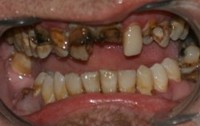 Severe Erosion - Drug Induced Saliva Chemistry Imbalance
Severe Erosion - Drug Induced Saliva Chemistry Imbalance
Enamel Rehabilitation
In situations where enamel deterioration is becoming more evident, enamel resurfacing or replacement can be achieved through a choice of lamination technologies (porcelain veneers) or entire tooth restoration via cemented crowns, porcelain jackets, or implant-supported crowns.
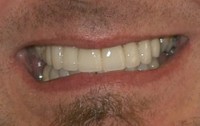 Successful Eroded Enamel Reconstruction
Successful Eroded Enamel Reconstruction
Representative Treatment Example
The last two pictures in our photo series represent the treatment of an actual enamel replacement and reconstruction need for a patient who was diagnosed with enamel erosion due to methamphetamine abuse. The resulting severe xerostomia destroyed the enamel and tooth structures. Combinations of porcelain crowns, veneer laminates, and dental implants were used to recreate what Mother Nature once provided for this young male.
